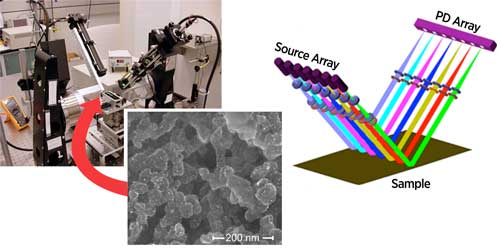| Oct 04, 2017 |
Scientists find a way to measure fuel cell 'printing' at a fast clip
|
|
(Nanowerk News) If you’re wondering when a hydrogen-powered car will become a viable option for you, take heart. A team including scientists at the National Institute of Standards and Technology (NIST) may have overcome a significant hurdle to manufacturing hydrogen fuel cells by creating a way to check whether the expensive catalysts the cells need have been incorporated quickly and effectively (Journal of Power Sources, "Development of large aperture projection scatterometry for catalyst loading evaluation in proton exchange membrane fuel cells"). Improved measurement methods are key to bringing hydrogen power a step closer to economical mass production.
|
 |
| Well-controlled illumination allows the team's prototype device (top left) to scan thin layers of liquid containing platinum nanoparticles (lower center), a catalyst used in fuel cells. Scaling up the approach (right) could help meet industry's quality-control needs. (Image: M. Stocker / NIST)
|
|
Hydrogen vehicles have not conquered the road like electric ones have yet, but it’s not for lack of efficiency or environmental friendliness. Hydrogen gas contains about three times as much energy by mass as fossil fuels do, and a fuel cell’s only byproduct is water. But, while filling a fuel tank with hydrogen is fast, building the engine is not, at least by industrial standards. A fuel cell requires thin layers of a platinum-based catalyst to convert hydrogen into electric energy, and the industry has lacked an efficient way to evaluate the layers’ properties. That lack is one reason only about 1,800 hydrogen vehicles were on the road as of a year or so ago, and they can cost twice as much as a conventional vehicle.
|
|
The catalyst needs to end up as two thin layers on either side of a polymer sheet that resembles plastic wrap, so the industry’s approach has been to treat the catalyst like ink. The process mixes platinum particles with carbon to form a deep black fluid that even looks ink-like. Then a machine resembling a newspaper printing press lays the mixture down as the sheet unspools from a giant roll. The problem is that the platinum in this ink costs upwards of $35 per gram ($1,000 an ounce), so manufacturers need a way to make sure just enough is laid down to get the job done—and not one costly drop more. And the process has to be fast enough to make fuel cells for thousands of cars per year, meaning the plastic has to roll quickly.
|
|
The team, which included scientists from NIST and industry, found an answer stemming from their experience measuring small objects for a completely different industry: computer chip manufacturing. But their usual approach, based on reflecting a laser’s light from a chip surface, demanded a rethink.
|
|
“We’ve got expertise in optical methods for measuring features smaller than 10 nanometers on chips, and the platinum particles are at the same scale,” said NIST physical scientist Michael Stocker. “We knew basically what we were doing, but chips don’t fly by at 30 meters (about 100 feet) per minute, so there was a speed challenge. Plus, you’re looking at something that’s black, so we didn’t have much reflected light to measure.”
|
|
After addressing this challenge through research and development, the team built a novel instrument using off-the-shelf technology that can detect the low levels of light reflected off the tiny platinum particles as the sheet moves past at a meter or two per minute.
|
|
Stocker said there are no fundamental barriers to scaling up the method or increasing the speed to meet the industry’s future needs. For instance, a manufacturer could array a row of these instruments to scan a meter-wide sheet, with each one identifying trouble spots in a particular section. Though the method would likely need to be combined with other techniques such as X-ray fluorescence to form a complete solution, Stocker said that it leaves fuel cell manufacturers in a good place.
|
|
“It’s all just optical engineering from this point onward,” he said. “Industry can take it from here.”
|

